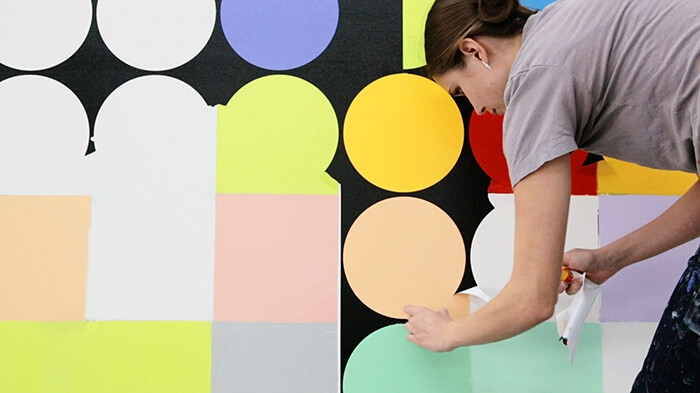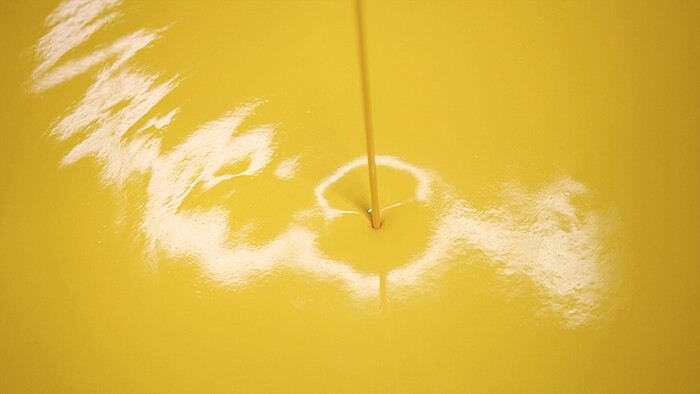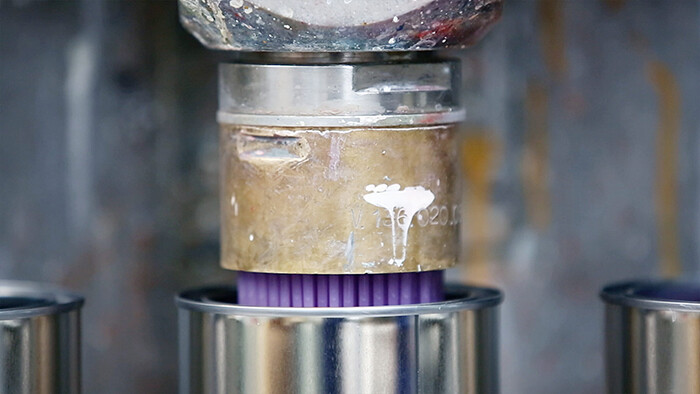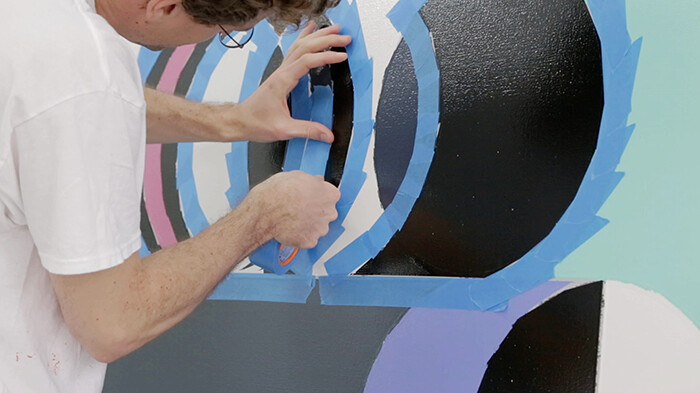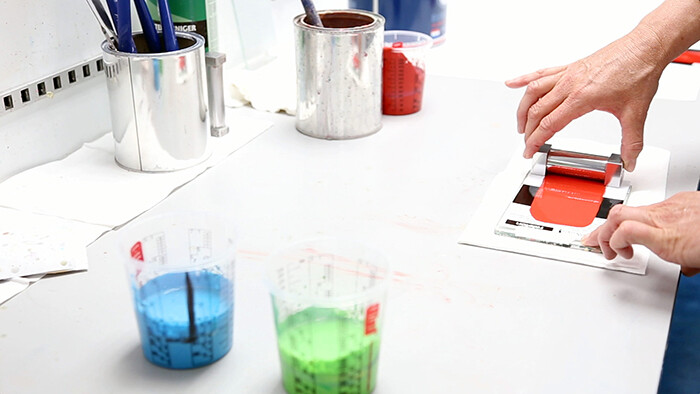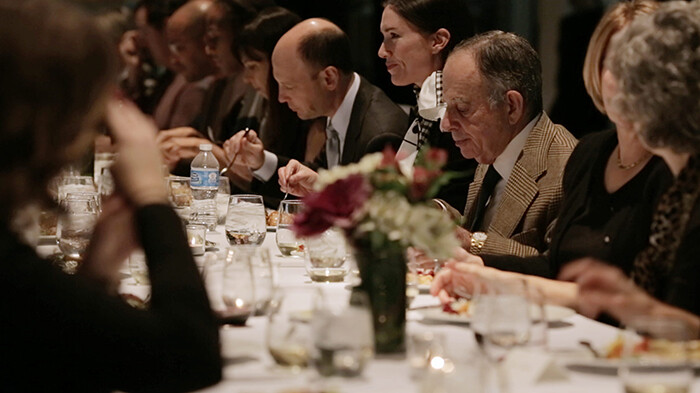During Art Basel’s preview days most visitors appear to be elderly heterosexual couples. More so than having children, collecting art bears the promise of keeping wealthy couples together. Children grow up and leave the house, but the collection stays and can grow forever. Like people, collections cannot be divided without killing them—still, that’s what a divorce asks you to do.
From a cynical perspective, husbands only collect art to give their wives the illusion that they still share some substantial interests with them, and wives only collect art to give their husbands the illusion that they have lost all libido beyond the little sex and eroticism they still experience together.
While the female half of this collector couple rather tries to resemble an artwork—colorful and ageless—the male part rather imitates the appearance of money with monochrome (preferably dark blue) suits. Of course there are exceptions to the rule, in particular when both spouses try to resemble artworks, or when both spouses try to resemble money.
Collecting art is the best that bourgeois society has to offer to reassure that sex isn’t everything a man and woman could share. Food makes you fat, drugs make you stupid, sports make you attractive again and subsequently raise your sexual appetite.
Basel hosts the most important art fair—Art Basel—and the most important jewelry fair—Baselworld. The main difference between art and jewelry is related to sex. Art leads away from sex, jewelry leads towards sex. A man who gives a woman jewelry is either courting her or distracting her from his courting another woman. A woman buying herself jewelry is imitating what it is to be courted and empowering herself, as though using a dildo.
There was a time when art was a pretext for the display of erotic nudity. This era ended pretty much with the invention of photography. Today art rather seems to distract from sex. It’s in the same category as antidepressants, while jewelry is the same category as Viagra.
When visiting the bar of Hotel Les Trois Rois during Baselworld you see dozens of women completely head-to-toe in black Chanel. They look like Amazons and keep their distance from the men. Meanwhile the men smoke cigars, i.e. penises. During Art Basel, the men and women at Les Trois Rois rather stick together. The women are preferably in pastel colors and either make an effort to amuse the men or request that the men amuse them. The men halfheartedly play the game. Back in their hotel rooms the women will be frustrated enough not to want sex. The men will have lost interest in insisting, which will make the women even more frustrated. Les Trois Rois’ cigar bar is abandoned. At the Kunsthalle’s Campari bar youngish people are decently dancing to rock and roll. It’s pulling them back to sexually innocent times when even their parents hadn’t started to ejaculate and ovulate.
Arts-and-crafts jewelry isn’t as sexually loaded as proper jewelry. The latter has expensive materials as an indispensable condition. Like sexual attraction, the value of proper jewelry is dominated by ruthless criteria. The art world doesn’t judge work in such a strict way. This attracts a big crowd of artists, gallery owners, and collectors, who try to play the game. Art Basel is more of a gold mine than a vault, and its fringes are still unclaimed. All a self-proclaimed prospector needs is a tiny corner in a friend of a friend’s apartment for a bit of sleep. As it’s summer, even a balcony will do. Switzerland is expensive, but during Art Basel there are plenty of opportunities for free food and drinks. Wages are too high for a rigorous, labor-intensive door policy. Still, except for a bit of fun and a bit of networking, most of the prospectors will be disappointed. As the criteria for inclusion and exclusion are a bit vague, the distrust of the established art world is even bigger. The art world is not keen to produce magic moments but rather to frame art-making, exhibiting, and collecting as proper work. Proper work in a post-Fordist sense—lacking the sexual stimulations of sweat, pain, and order.
In the Unlimited section of this year’s Art Basel, Anna Gaskell is showing her recent documentary Echo Morris (2014), a portrait of artist Sarah Morris, with Cologne’s Galerie Gisele Capitain. Its crisp images and its pumping soundtrack copy the style of Morris’s own documentaries on the aesthetics of power. The soundtrack (all songs are from the synth-pop label Italians Do it Better) and the editing are a bit more uptempo and give the impression of an enormous sexual tension. Morris’s studio, her home (a vast white and glass cube designed by Paul Rudolph), and her exhibition openings appear as an endless catwalk. Even though we don’t see Morris with her friends or her kids, there is no doubt that it is only to maintain their privacy. Every grin, every scribble, every drag on a cigarette aims at perfection. Not in the sense of the moronic flawlessness of the digital microscope, but of the total view of the analogue. With her red lipstick, her cool looks, and her upright posture, Sarah Morris presents herself as a feminist resurgence of a Guy Bourdin model: a proficient working girl who is able immediately to turn any situation into her very own setting. As soon as she’s about to film the Eiffel Tower it’s hers. Her straight hair is an advanced helmet, and the spots on her face are traces of glorious battles.
Men have never been that perfect. At home, Andy Warhol was a compulsive hoarder, and Jeff Koons training naked at his studio is an obvious staging. But Anna Gaskell’s intriguing documentary makes you believe that Sarah Morris is really living her dream of a re-sexualized art world, 24/7.
Last night, fleeing from finally writing this text, I went dancing. It must have been 3 a.m. At the club, there she was.

